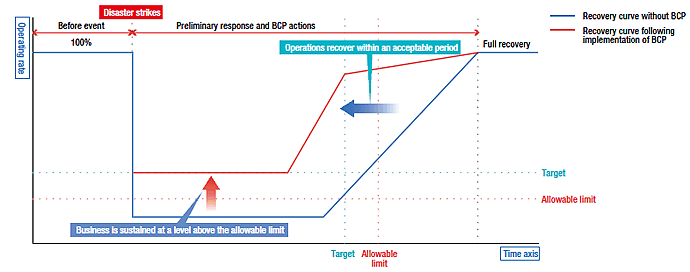Review of Business Continuity Plan
A business continuity plan (BCP) is itself a management strategy. It requires more than just typical preparations, such as setting up disaster-prevention equipment and running evacuation drills, to expedite emergency responses in the wake of a disaster. It must also detail approaches to ensure that business continues without interruption and that the corporate mission is fulfilled. The lessons learned in the Great Hanshin Earthquake, which hit the Kobe area in January 1995, formed the basis of the Group’s disaster-prevention measures, and the outbreak of a new influenza virus in 2009 prompted the establishment of a BCP. However, with the Great East Japan Earthquake of March 2011, the BCP was revised to enhance the Group’s ability to deal with the consequences of a large-scale earthquake.
1. Basic Corporate Policy
Determine course of action to be taken by the KHI Group in the event of a large-scale earthquake
Basic corporate policy has been set for the KHI Group that clarifies courses of action to be taken in an emergency.
Naturally, human life is the highest priority, and once again we documented our commitment to fulfilling the social responsibilities incumbent upon an enterprise that plays such an essential role in the creation of social infrastructure. When a large-scale earthquake strikes, our focus must be on operational support for equipment, including aircraft and naval vessels, used in rescue activities, and efforts to restore and repair infrastructure systems or components thereof, such as rolling stock, power generation facilities and waste-processing facilities, as quickly as possible and to assist our clients and business partners in returning operations back to normal.
Basic Corporate Policy
- Ensure safety and health of employees and their families.
- Ensure services and products that are essential to the fulfillment of corporate responsibility go on without interruption.
- Get Group operations back to normal.
- Acknowledge responsibility to local communities and contribute to each region.
2. Head Office and Internal Company Priorities
With the basic corporate policy in mind, designate functions to be maintained at the head office and internal companies in the event of disaster.
We have identified priorities for the head office and internal companies in line with our basic corporate policy and have designated certain functions that must be maintained even in the event of disaster with due consideration given to the different business content of each internal company and the features inherent in products and services.
3. Response in Time of Disaster and Preparation during Normal Time
Consider responses appropriate in the wake of disaster and prepare for the eventuality of such events during normal times.
Many disaster scenarios indicate the possibility of a massive earthquake centered directly under Tokyo as well as a cascadelike triple megaquake event along the Tokai–Tonankai–Nankai segment of the Pacific Ocean coastline. Bearing these potential events in mind, we considered the responses necessary should such catastrophes occur and activities that could be undertaken during normal times to prepare for such eventualities.
We formulated a plan that designated specific divisions with a specific task, and outlined preparations necessary to achieve the desired objectives. Preparations are moving ahead in line with this plan.
4. Drills and Revisions
Drills are undertaken regularly and content is revised based on results.
We are constantly running BCP drills and revising BCP content based on how the drills were performed.

What is a BCP?
The diagram below illustrates the concept of a business continuity plan (BCP). Showing operating efficiency on the vertical axis and elapsed time on the horizontal axis, it demonstrates the flow of recovery after a crisis. As indicated, operating efficiency drops suddenly just when disaster strikes, and then gradually recovers over time. With a BCP and preparations put in place during normal times, the following results can be expected.
- The impact on business, mainly the drop in operating rate that coincides with the disaster event, is held within the allowable range. That is, we realize a diminished impact on operations directly after the disaster event.
- The recovery period is shorter. That is, recovery is achieved more quickly.

Kawasaki Group Crisis Management System
When a disaster, such as a largescale earthquake, occurs, the Company implements special business activities different from usual and requiring urgent action, such as confirming the safety of employees and initiating recovery operations.
To address emergencies quickly as circumstances demand, we have set up the following command centers.
| Key Role | Location | |
|---|---|---|
| Corporate Command Center |
Set up in the event of a crisis that requires a companywide response; determines measures to be implemented throughout the Group and basic policy on action plans. | Office that has not sustained any damage In principle, either the Kobe Head Office or the Tokyo Head Office |
| Integrated Plant Command Center |
Determines issues related to all plants; coordinates with internal companies. | Plant facilities of several internal companies |
| Company Command Center |
Provides internal company support in areas devastated by the disaster; determined responses to affected suppliers and customers. |
Appropriate location at each internal company |
| Local Command Center |
Determines responses for business segments and business offices. | Office that sustained damage |
Contact
If you need more information about our business,
please feel free to contact us.





